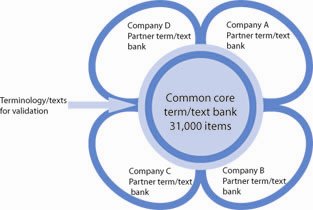
At first sight the TermFlower seems like an ordinary internet-based dictionary/text bank. But behind the well-known and familiar appearance the user will find an efficient tool for knowledge sharing and improvement of the organisation's communication.
Common term/text bank
In the centre of the TermFlower is a large group of dictionary entries/texts within the chosen subject area. This may be e.g. law or medicine. The entries/texts are organised by language and assigned categories such as word class, synonyms, definitions and comments. Instead of representing a static knowledge as do ordinary works of reference, the TermFlower is dynamic and invites all to participate in the continuous development of the dictionary/text bank. Thus, you may suggest alternative translations, new entries/texts or other definitions/translations to the entries/texts that other users have chosen to share. All users may participate and influence the tool within their product area or research field. The advantage is, naturally, that all users gain access to specialised and new knowledge from researchers, colleagues and employees in other organisations working within the same field: Knowledge which would normally require a lot of resources to obtain.
Internal dictionary
Each participating organisation is given their own internal dictionary/text bank in which an administrator approves the users' suggestions and submits some or all of them to external validation. If a suggested concept/text is validated by both the technical and the linguistic expert in the dictionary/text committee, it will be visible for all the organisations in the TermFlower.
While the internal dictionary/text bank is an expression of the language policy implemented by the company, the common core is an expression of the industry's authorised translations and established concept definitions/translations. Comparing one's own practice with the industry's standards offers great benefits and makes it easier to make well qualified choices when the language policy is implemented in everyday life's text production/handling.
The principle for the internal dictionaries/text banks is the same as for the common core: users may add, edit and comment existing entries/texts and approve or reject suggestions for the common core. The organisation has absolute decision-making authority concerning the assignment of user roles, including the assignment of the administrator role which has the power to approve suggestions to the internal dictionary/text bank and to the core of the TermFlower.
Advantages within knowledge sharing
It is quite simple to use the TermFlower. Thus, the use of the TermFlower provides concrete advantages within knowledge sharing with a view to making the organisation's communicative output more effective:
The Dictionary of Medical Science is an example of the TermFlower used within the subject area medicine and medical science. It has been in use since 2004 by e.g. educations within medical science, the IT industry, translation companies, patent agencies and the pharmaceutical and medical industries.